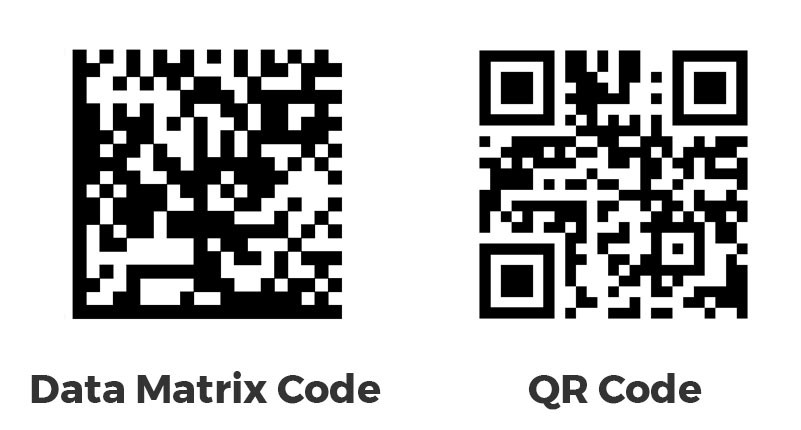Automotive Part Marking Technologies - Which One to Choose?
If you are struggling to find a marking method for traceability, or simply for process improvement, you are not the only one.

2D codes such as data matrix and QR codes are used in almost all industries to share information about the parts or products on which they are marked. For example, the codes that are shown above both store the URL to the Laserax website. If you have a smartphone, you can find an application to scan these codes and open our website in your web browser. In the case of parts and products, codes like these are scanned at every stage of the production and delivery process to track them and store valuable information in a database.
Free Guide on Industrial Traceability
A data matrix code is a 2D code that is made of black and white cells that are typically arranged in a square pattern (although rectangular patterns also exist). The number of rows and columns increases with the amount of information stored in the code, which is limited to 2,335 alphanumeric characters. The L-shape that follows its borders is its finder pattern, which is used by scanners to recognize and read the code. The use of data matrix codes is standardized thanks to the ISO/IEC 16022 international standard.
A QR code—or quick response code—is a 2D code that is made of black cells arranged in a square grid on a white background. It can store a maximum of 4,296 alphanumeric characters. The maximum number of characters is mostly determined by the number of rows and columns. Its finder pattern consists of three square structures in its corners, which makes it easy to recognize. QR codes are used similarly worldwide thanks to the ISO/IEC 18004 international standard.
You may find that both codes look similar. The differences that matter, however, cannot be seen by the naked eye! We have summed up for you the main differences between each type of 2D code to help you understand which one is right for you.
| Data Matrix Code | QR Code | ||
|---|---|---|---|
| Maximum storage The maximum storage capacity is reduced if the size of the code is smaller, or if the error correction level is higher. | Numeric characters only: 3,116 Alphanumeric characters: 2,335 Binary characters: 1,556 Kanji/kana characters: not supported | Numeric characters only: 7,089 Alphanumeric characters: 4,296 Binary characters: 2,953 Kanji/kana characters: 1,817 | |
| Size The bigger the size of the code, the more information can be stored in it. Its size is determined by the number of cells in it. | Increments Different versions of the code exist. The difference between each version is the number of cells by which the code is incremented. | 2 cells | 4 cells |
| Minimum size | 10x10 cells | 21x21 cells | |
| Maximum size | 144x144 cells | 177x177 cells | |
| Error correction level (ECL) The error correction level is the percentage of the code that can be damaged before it is no longer readable. | Maximum: 30% Automatically determined by the code size and the remaining storage capacity. | Low: 7% Can be selected manually. A higher ECL means less storage capacity. |
We’ve prepared a list of questions for you to consider when the time comes to choose between data matrix codes and QR codes. We’re confident that with this information, you will be able to make the choice that best suits the needs of your application.
Size matters! Both data matrix codes and QR codes are scalable, but small components such as electronic devices are typically marked with data matrix codes since they can encode more characters within the same space. Some markings have cells that are as small as 300 μm2, whereas other markings are as large as a 1 m2. QR codes are less compact in size and are therefore not typically used for small items.
Lasers are very useful to mark data matrix codes on small components. See this video for an example.
Traceability demands that codes be readable from the beginning until the end of their lifecycle. For example, if the parts that you produce are treated using abrasive blasting such as shotblasting and sandblasting, chances are that the readability of your codes will be affected. The error correction level can be used to account for some damage to the code, but a code that is shotblast resistant is even better. See this article for information on shotblast resistant laser marking.
Grades indicate the overall readability of a code and range from A to F. Different international ISO standards exist to determine the quality of 2D codes. When direct part marking is used, ISO/IEC TR 29158 (also known as AIM DPM) is used to evaluate quality using eight parameters: axial non-uniformity, cell contrast, cell modulation, decodability, fixed pattern damage, grid non-uniformity, minimum reflectance, and unused error correction.
2D code verifiers such as the ones manufactured by Cognex can be used to evaluate a code’s grade.
Depending on where you operate, your industry may be regulated by organizations that dictate or provide recommendations on how to use 2D codes. Here are some examples:
You can encode lots of information in 2D codes, but there are limitations. Both types of codes work just fine if you want to use alphanumeric or binary characters. However, the QR code, which was first adopted by the automotive industry in Japan, is the only type that supports Kanji and Kana characters. If you want to use a specific type of code, you must be prepared to work with its limitations.
Laserax sells inline laser marking machines that can be used to mark 2D codes on the parts that you manufacture. Click here for information on how our laser technologies can be used for 2D code marking. You can also ask a Laserax expert for more information on how you could apply our laser technologies to your needs for 2D code marking.

Keven is the product line manager for Laserax’s battery welding solutions. He has a strong background in electrical engineering, especially in PLC programming, electrical design, and vision systems. He is often involved in evaluating customer needs to offer adapted industrial solutions.